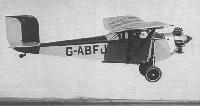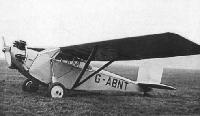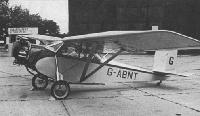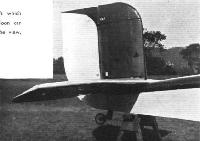
Flight, June 1929
THE CIVILIAN COUPE
A New British Light 'Plane for the Private Owner
WE are able to give this week general arrangement drawings of an entirely new British light 'plane, which is now almost ready for its first flights. This machine, the "Civilian Coupe 1," has been produced by the Civilian Aircraft Co., of 27, Moor Street, Burton-on-Trent - a company that has just recently been formed to carry out experimental work in connection with a new type of Private-Owner light 'plane, and other machines.
The "Civilian Coupe" has been designed - specially for the Owner-Pilot - by Mr. Harold D. Boultbee, who, as no doubt some of our readers are aware, has been associated with aviation since 1909; for the last six years, for instance, he has been designing for Handley Page, Ltd. Mr. Boultbee has formed the company with the assistance of some friends in Burton, viz., Mr. T. R. Shercliff, Mr. W. B. Briggs, Mr. S. H. Buxton, and Mr. T. S. Green.
We can only give but brief particulars of this machine at the moment, but very shortly we hope to give a fuller, illustrated description. As will be seen, it is a braced high-wing two-seater monoplane, with a 75-h.p. A.B.C. "Hornet" engine. Its special features may be summarised as follows :- All 3-ply covering throughout, finished with Cerric cellulose lacquer. All controls by sliding rods. Ball bearings to all moving parts. Ball joints enclosed in leather sleeves to all chassis joints. Folding wings. Two side doors, staggered seats, detachable wind shields. Detachable engine unit, including oil tank, instrument panel and all controls, pipes, etc. Unimpeded view in all directions, including backward view when tail on ground. Very robust construction throughout, to stand hard wear.
The principal characteristics and performance are :-
Span 35 ft. 6 3/8 in.
Chord 5 ft.
OA. length 19 ft. 4 in.
Height 6 ft. 3 in.
Width, folded 11 ft. 2 in.
Wing area 1678 sq. ft.
Total weight (normal) 1,560 lbs.
Weight/h.p. (normal) 19 lbs.
Weight/sq. ft. (normal) 9-3 lbs.
Speed range (apx.) 42-100 m.p.h.
Climbing speed 670 ft. off ground
Ceiling 12,500 ft.
Описание:
- Flight, June 1929
THE CIVILIAN COUPE - Flight, April 1930
AIRCRAFT FOR THE PRIVATE OWNER - Flight, April 1931
THE CIVILIAN COUPE
Фотографии
-
Aeroplane Monthly 1998-12 / M.Oakey, T.Harmsworth - News
Регистрационный номер: G-ABNT [6] Meanwhile a visitor to Old Warden has provided a useful reference source for the Martlet’s Genet Major engine installation. Civilian Coupe G-ABNT has a similar powerplant, and its owners Shipping and Airlines at Biggin Hill kindly allowed Shuttleworth’s engineers to study it and its mounting. The Coupe departed Old Warden on October 4, 1998.
-
Aeroplane Monthly 1987-09 / S.Porter - Recuperated Coupe
Регистрационный номер: G-AAIL [5], EI-AAV [5] Another view of the prototype Coupe. The schoolboy standing by the nose gives an idea of scale. In August 1933 'IL was sold in Ireland and became EI-AAV.
-
Flight 1930-04 / Flight
Регистрационный номер: G-AAIL [5], EI-AAV [5] The new Civilian Coupe at Heston which is fitted with the A.B.C. "Hornet" and carries two in the enclosed cabin. Beside the nose is Mr. Hunt, Works Manager.
-
Flight 1930-04 / Flight
Регистрационный номер: G-AAIL [5], EI-AAV [5] -
Aeroplane Monthly 1987-09 / S.Porter - Recuperated Coupe
Регистрационный номер: G-AAIL [5], EI-AAV [5] The prototype Civilian Coupe, fitted with a 75 h.p. ABC Hornet engine, at Heston in July 1929.
-
Aeroplane Monthly 1987-09 / S.Porter - Recuperated Coupe
Регистрационный номер: G-AAIL [5], EI-AAV [5] The same aircraft with lengthened nose, shortened exhaust pipes and faired undercarriage struts.
-
Flight 1931-04 / Flight
Регистрационный номер: G-ABFJ [6] -
Flight 1931-04 / Flight
Регистрационный номер: G-ABFJ [6] -
Aeroplane Monthly 1987-09 / S.Porter - Recuperated Coupe
Регистрационный номер: G-ABFJ [6] The Civilian Coupe is the first two-seater to give side by side enclosed seating with a really good view, an excellent performance and low cost. Fitted with wheel brakes, this makes an admirable private owners' machine.
-
Aeroplane Monthly 1987-09 / S.Porter - Recuperated Coupe
Регистрационный номер: G-ABFJ [6] Two views of the third Coupe, G-ABFJ, taken during the summer of 1931. Registered in April that year, 'FJ met its end following a forced landing three months later.
-
Flight 1931-04 / Flight
Регистрационный номер: G-ABFJ [6] -
Aeroplane Monthly 1987-09 / S.Porter - Recuperated Coupe
Регистрационный номер: G-ABFI, G-ABFJ [6] Coupes G-ABFI and G-ABFJ taking off from Heston on May 30, 1931 at the start of the London to Newcastle air race. G-ABFJ ran out of fuel and ’FI was placed 7th with an average speed of 119 m.p.h.
-
Aviation Historian 1 / P.Jarrett - Under the windstocking
Регистрационный номер: G-ABNT [6] CIVILIAN AIRCRAFT Co Ltd Coupe II G-ABNT was built at Hedon, Yorkshire, in 1931, and Flt Lt Bowling flew it to tenth place in the Heston-Cardiff race on september 19 that year, averaging 89 m.p.h. on its 100 h.p. Armstrong siddeley Genet Major I engine. After being acquired by S.B. Cliff early in 1933 it was based first at Woodley and then at Whitchurch. Later that year it was acquired by Mr G.O. Rees of Cardiff, who flew it from the sands along the south wales coast. In 1939 it was dismantled at Carmarthen, and survived to be sold in 1978 to Shipping & Airlines Ltd, which restored this unique survivor to airworthy condition. “Bunty”, as it is affectionately known, is now based at Biggin Hill.
-
Aeroplane Monthly 1987-09 / S.Porter - Recuperated Coupe
Регистрационный номер: G-ABNT [6] Coupe G-ABNT photographed at Heston in July 1932.
-
Aeroplane Monthly 1987-09 / S.Porter - Recuperated Coupe
Регистрационный номер: G-ABNT [6] 'NT in 1931, soon after it was built.
-
Aeroplane Monthly 1987-09 / S.Porter - Recuperated Coupe
Регистрационный номер: G-ABNT [6] 'NT shortly after restoration at Biggin Hill last year.
-
Aeroplane Monthly 1987-09 / S.Porter - Recuperated Coupe
Регистрационный номер: G-ABNT [6] Civilian Coupe G-ABNT, pictured during a test flight in almost 50yr.
-
Aeroplane Monthly 1987-09 / S.Porter - Recuperated Coupe
Регистрационный номер: G-ABPW, D-EPAN The sixth and final Coupe was G-ABPW. In October 1932 it was delivered to a German firm of aerial photographers and, registered D-EPAN, survived until the Forties.
-
Flight 1931-04 / Flight
A MODERN TAIL: The tail wheel shows the thoroughly practical way in which the Civilian Coupe has been designed as regards such details. This fitting makes the Coupe very comfortable when taxying.
-
Aeroplane Monthly 1987-09 / S.Porter - Recuperated Coupe
A COMFORTABLE ARRANGEMENT: No one can complain of the comfort provided in the cabin of this machine. It will be seen that the seats are slightly staggered thereby giving ample shoulder room.
A large celluloid panel in the roof gave the pilot a clear view above. -
Flight 1929-07 / Flight
Civilian Coupe Light Plane 75 hp A.B.C. "Hornet" Engine
- Фотографии





















